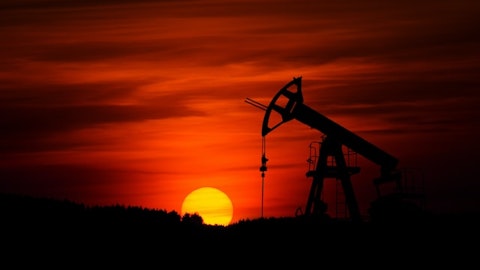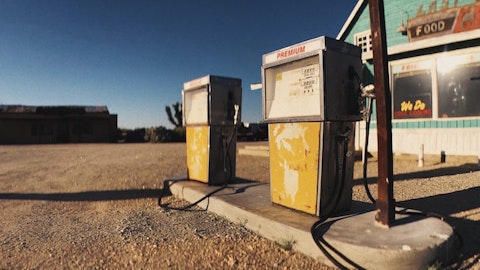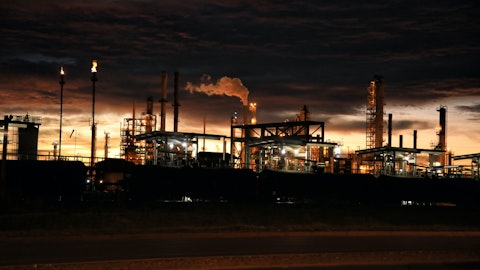Mark Smith: No, I think that’s fair. I mean there’s no doubt that we have a desire to grow our international footprint. As we all know when you talk about U.S. activity and U.S. production and what’s currently going on, as we know, production levels are not necessarily directly aligned with the current rig count that we’re experiencing. And we’ve seen it previously, but we have capacity here in the U.S. to export FlexRigs into international markets. So that’s been one of our strategies for the last couple of years and we’re starting to see, as I said earlier, we are starting to see a lot more activity, a lot more bids out there to participate in. And so again, we’re encouraged by that. But I think it’s also important to recognize that it’s very, very hard to predict rig counts and activity out multiple years, much less a couple of quarters as you know.
We had fully intended to get our rig count to 191 during 2023 and we got up to around 187 or so and then of course we had a market – the market correction that we’ve all experienced. And so that can happen out of left field. Who knows what happens when natural gas prices strengthen in 2024 or 2025 timeframe. So it’s a – there’s a lot of time left ahead of us, but clearly to your original point, we’re definitely planning to grow internationally.
Kurt Hallead: Got it. That’s great. Really appreciate it. Thank you.
John Lindsay: Thanks, Kurt.
Operator: We’ll take our next question from Waqar Syed with ATB Capital Markets. Please go ahead. Your line is open.
Waqar Syed: Thank you for taking my question and good morning. Your performance-based contracts been running for a while, good to see the basket has gone up. If you look back over the last year, year and a half, how much do you think the performance-based contracts have added to the underlying data driven margins?
Mark Smith: Uh, 1,000 to 2,000 per day on average when those bonuses are added in and average back.
John Lindsay: That’s average out on a per rig.
Mark Smith: Yes.
John Lindsay: So it’s double that on the rigs that are – that actually have performance-based contracts.
Waqar Syed: Oh, okay, okay. So it’s been pretty in line with what your expectations were going in?
John Lindsay: Waqar, you know, we’re pleased with where we are. We think we have additional progress to make on the performance-based contracts. I think it makes – that model really makes too much sense for what’s going on in our market in unconventional wells and the need to be more reliable and drill longer laterals, all of that I think it makes a lot of sense, and particularly when you’re deploying additional technology and capacity and automation and things like that. So I think there’s still further growth in terms of a percentage of our rigs, and I think there’s the potential growth on the additional margin that we’re delivering just based on how we continue to improve and how that compares to competitor performance. So I’ve said this before, do I think we’re going to have ever have 100% of our rigs on performance?
No, I don’t necessarily think that. But it wasn’t that long ago that we were at, oh gosh, probably 10% to 15% of our fleet and today we’re at 52, and we’re starting to see some additional growth with performance-based contracts. So we’re encouraged by the opportunity.
Waqar Syed: Okay, and then your capital allocation framework that you’ve mentioned in your supplemental dividends, regular dividends and CapEx guidance, so if we reverse engineer from there to the expectations of EBITDA, I think consensus right now for fiscal year 2024 is about $872 million. So you feel comfortable with that consensus range and maybe upside a little bit there as well in your guidance, your capital allocation guidance?
Mark Smith: Waqar, really, no further comments to the numbers we put out to do the math.
Waqar Syed: You’re leaving the hard work to us then.
Mark Smith: Yes, sir.
Waqar Syed: Okay. And then just finally, the U.S. offshore, anything kind of out there which could increase the active count further?
Mark Smith: Well, as we mentioned, offshore we had the one rig —
Waqar Syed: Right.
Mark Smith: That demobilized the stack as expected and our sales team does have a line of sight to a couple of potential opportunities that could occur in the back half of the fiscal year, but nothing definitive on that.
Waqar Syed: Okay, thank you very much. Thanks for taking my questions.
John Lindsay: Thanks, Waqar.
Operator: We’ll take our next question from Keith Mackey with RBC Capital Markets. Please go ahead. Your line is open.
Keith Mackey: Hi, good morning. Just looking back over the last year, certainly in the U.S. rig counts have come down, day rates came off of the, you know, leading edge peak that we saw late last year, early this year. But I think things have probably held in, you know, from a rate perspective, more stable than a lot would have expected given the amount of rigs that have come out of the industry for now. So I guess the first part of the question is, you know, would you agree with that? And the second part is, what if anything has surprised you about how the industry has responded to decrease in demand over the last year? Would you have expected things to be, you know, yourselves to be much worse than this or much better or, or any comments around that would be appreciated?
John Lindsay: Well, I’ll start with the last part of your question. You know, I think when you consider – and I mentioned this earlier, the pullback in gas prices and the activity associated with that, I don’t think that part is a surprise to us or really to anyone and I think there’s an opportunity of course for that to improve going forward. I think the oil side of the equation is probably a little – maybe a little bit more surprising, but it goes back to that theme that we mentioned related to churn. It’s amazing the amount of, whether it’s private or public, mostly I think related to private, but there’s just a consistent – a continuous churn of rigs getting released and getting put back to work. Our sales force is doing a great job with that and that leads into the pricing.
And at the end of the day, we work very hard to partner with our customers to deliver the highest level of efficiency value as possible and doing it in a very consistent way. And that’s worth a lot, and we hear that from customers day in and day out that reliability, being able to drill those wells effectively and efficiently is worth a lot. And so again, it starts with, as I said earlier, it starts with our customers and that’s being more disciplined in terms of their spending and that really puts the requirement on us to do the same thing and just making certain that we’re getting a return for the capital that we’re investing. As you know, it’s a high capital-intensive business, drilling is. And we’re investing a lot of money and we have great people and great technology and we’ve got to get paid for that.



